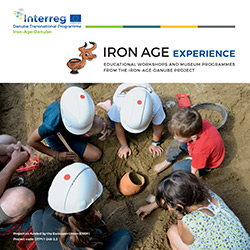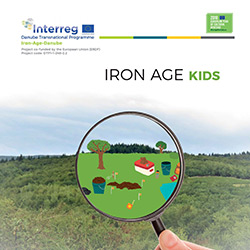
Iron-Age-Danube was a cross-border project, part of the Interreg Danube Transnational Programme of the European Union. It lasted from 2017 until 2019. It counted 12 partners and seven associated organisations from in Austria, Croatia, Hungary, Slovakia and Slovenia. The major goal of the project is to communicate a lively image of archaeological research and the Iron Age landscapes to the visitors and to raise the awareness for the importance of archaeological monuments for the human history. Another goal is the protection of the monuments and landscapes as well as their sustainable use for the tourism. For communication purposes, several booklets were produced, available as free PDF downloads.


Iron Age Experience
| Lucian Petre Vulpe (RO)
Iron Age Experience is a compilation of educational workshops that are part of a cross-border programme called Iron Age Danube Project. The compilation contains 111 pages, divided into five categories, in which are described activities on various topics focused mainly on the first Iron Age period.
The theme of the workshops is an important one in the current context, where technology is ever present in children’s lives. The idea of highlighting the lifestyle of the Iron Age through practical activities takes students out of their routine and invites then to live in a world almost 2000 years ago.
Workshops for children were divided into five sub-categories: plants and food, building and crafts, clothing and equipment, art and music, prehistoric landscape and archaeological research. All these workshops included fun activities, where children, through various games and activities - such as the development of models of housing, pouring metal into moulds, pottery workshop, loom and simulated excavations - learn about artefacts from the first Iron Age. They learn how they were produced, how they were used and how they are discovered in an archaeological excavation. Doing this, they learn about objects we use every day and their historical background.
One of the strengths of this project is its adaptability. It is designed in such a way that many of the workshops and activities can be adapted depending on the period or era that we want to illustrate, customizing each task. Another advantage of this is that it can be applied not only to children, but also teenagers and even adults. The fact that today, people who practice centuries-old crafts are rare helps makes such a project a major attraction. It can become a magnet for tourists and even locals in cities that are homes to museums.
The originality of the project, its adaptability with a very broad target audience and applicability to all museums worldwide, no matter if it is a local or national museum, makes this project a “must have”, enabling museums to be more attractive and even fun. I hope the project will be applied in many museums, developing and leading to another level of museum pedagogy.
Book Information:
Daniel Modl (ed), 2018, Iron Age Experience, ISBN 978-615-5766-26-8, 111 pp.
Free download at: http://www.interreg-danube.eu/approved-projects/iron-age-danube/outputs…


Iron Age Kids
| Caroline Nicolay (UK)
This is a 27 page-long little book created for the Iron Age Danube project and intended for children. It efficiently covers many different topics presented in a simplified manner, each of them being treated over two pages and clearly colour coded to easily differentiate them. Children can learn about the Iron Age, with a focus on the Hallstatt culture; how archaeologists work (including the most modern technologies used in the field such as laser scanning and geophysical measures); what was life like at the time and what people were wearing; tumuli and burial practices; and even experimental archaeology.
The book has many photographs and drawings, with a colourful and clear design, and - least but not last- Tomi the mascot: an animated bull-headed ceramic vessel who talks directly to the reader or asks/answers short questions on the side of some pages, make this book very appealing and an enjoyable read for children. It also provides five different hands-on activities, including cooking hazelnut pancakes, making a bow and arrow, decorating a bookmark using wax crayons and ink, to replicate the decoration of graphite-covered pots of early Iron Age, making coloured cloth and drawing / placing cut out items on a silhouette to dress up the Kaptol warrior.
Some of the applied vocabulary might come across as slightly complex for young readers and could have benefitted with a definition, maybe by Tomi, who we always enjoy encountering throughout the book. However, this really does not impact the great presentation and content of this book, making it a perfect introduction to the early Iron Age in the Danube region.
Book Information:
Anja Hellmuth Kramberger (ed), 2018, Iron Age Kids, Budapest: Archeolingua, ISBN 978-615-5766-10-7, 27 pp.
Free download at: http://www.interreg-danube.eu/approved-projects/iron-age-danube/outputs…


Kaptol - Hallstatt food workshop and cookbook
| Caroline Nicolay (UK)
This 35 page-long cookbook details the recipes and techniques used during a cooking workshop held in September 2017 at the "Stari Fenjeri" restaurant, not far from the archaeological site of Kaptol in Croatia, during which the participants ("archaeologists and enthusiasts") tried to recreate parts of the Early Iron Age diet. The experiment was based on archaeobotanical and archaeozoological data collected from Iron Age graves discovered in Kaptol, with some cooking methods attested in the archaeological record.
The recipes used and shared in this book have been (re)created by the participants, with the aim to produce a possible historical menu that would also appeal to the modern visitor. The cookbook is separated into four sections: dishes cooked in a kettle; dishes prepared under a baking lid; dishes baked on a heated stone; and meat baked over an open fire.
The last section explains briefly how all participants got a chance to take part in the workshop by cooking pork meat on sticks over a fire, which was received as a "fun culinary experience". This is precisely where the main focus of this book lies: beyond tasty recipes using period ingredients and cooking techniques, the author wrote about the culinary value of the dishes produced to modern palates (and inevitably everyone's personal tastes), describing the combination of flavours created, visual impact of a dish etc. However, the author also described the reactions and opinions of the participants, which I would call the "human value" of the workshop. Overall it was a very successful and popular experience, which is not surprising seeing how popular ancient food workshops run in the UK have become in recent years.
It is unfortunate that a modern equivalent to the "baking lid" mentioned was used as it was too complicated to find a clay replica, though the cooking on a heated stone slab seems to have been a highly successful and memorable experience.
The nine recipes are accompanied by fantastic photographs, within a well written and neatly designed book. A short introduction offering the readers the possibility to learn more about the archaeological find from Kaptol which the experiment was based on could have been a great addition to the publication. This would have introduced, for example "baking lids", as a common way of cooking in the early Iron Age and reference to basil and chives, which are present in such early context would be incredibly interesting to read about (to Iron Age diet enthusiasts at least!).
Overall a brilliant book to dive into ancient food with recipes easy to try at home or around a campfire.
Book Information:
Ana Đukić (ed), 2019. Kaptol, Hallstatt food workshop & Cookbook, 35 pp.
Free download at: http://www.interreg-danube.eu/approved-projects/iron-age-danube/outputs…
